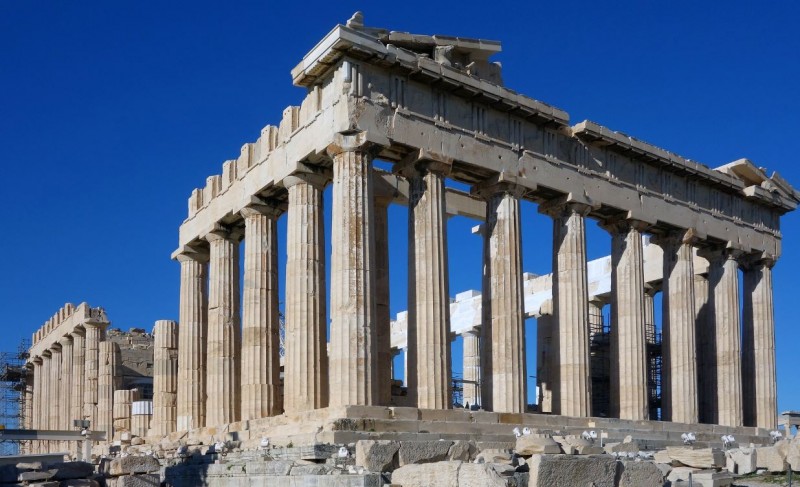
The Parthenon, a symbol of classical architecture and ancient Greek civilization, stands majestically atop the Acropolis in Athens, Greece. This remarkable temple, dedicated to the goddess Athena, has captured the imagination of people worldwide for centuries. Its rich history, architectural brilliance, and cultural significance make it a timeless monument worth exploring.
The Construction of the Parthenon
Architectural Design and Features
The Parthenon's construction began in 447 BCE under the guidance of architects Ictinus and Callicrates. The temple is a Doric masterpiece, known for its harmonious proportions and innovative design, which challenged the conventions of its time. The impressive use of columns, friezes, and pediments showcases the ingenuity of ancient Greek builders.
The Acropolis of Athens
Sitting atop the Acropolis hill, the Parthenon is part of a larger architectural complex that includes other significant structures like the Propylaea, the Erechtheion, and the Temple of Athena Nike. The strategic location of the Acropolis provided a defensive advantage and later became a hub for religious and cultural activities.
Purpose and Significance
The Parthenon served as more than just a temple; it was a symbol of Athenian pride and a testament to their dedication to the patron goddess Athena. Its construction also marked the pinnacle of the Golden Age of Athens, a period of unprecedented intellectual and artistic achievements under the leadership of Pericles.
The Golden Age of Athens
Pericles' Influence
Pericles, a statesman and general, played a pivotal role in transforming Athens into a dominant cultural and political force. His vision and support for the arts and philosophy laid the foundation for the city's Golden Age, during which the Parthenon became a monumental tribute to Athenian democracy and prosperity.
Cultural and Intellectual Flourishing
The Golden Age saw the rise of philosophers like Socrates, Plato, and Aristotle, along with playwrights like Sophocles and Euripides. This period witnessed the creation of timeless literary works and the establishment of the Academy and the Lyceum, which became centers of learning and philosophical debate.
The Parthenon as a Temple to Athena
The Cult of Athena
Athena, the goddess of wisdom and warfare, held a special place in the hearts of the Athenians. The Parthenon housed a colossal statue of Athena Parthenos, sculpted by the renowned artist Phidias. This statue, made of gold and ivory, was an awe-inspiring representation of the goddess.
Statue of Athena Parthenos
The statue of Athena Parthenos stood approximately 12 meters high and depicted the goddess in full armor, holding a shield in one hand and a spear in the other. The attention to detail and craftsmanship of the statue were remarkable, making it one of the most celebrated works of ancient art.
Religious Practices
The Parthenon was the focal point of religious ceremonies and festivals dedicated to Athena. Pilgrims from across Greece visited the temple to seek blessings and make offerings to the goddess. These rituals were an integral part of ancient Greek religious life.
The Parthenon Through History
Roman and Byzantine Eras
During the Roman period, the Parthenon underwent several changes, including conversion into a Christian church dedicated to the Virgin Mary. In the Byzantine era, the temple suffered damage due to invasions and earthquakes.
Ottoman Occupation
In the 15th century, the Ottoman Empire conquered Athens, and the Parthenon was transformed into a mosque. The addition of minarets altered its appearance, yet the structure's grandeur endured.
Elgin Marbles Controversy
The early 19th century saw Lord Elgin, a British ambassador, remove several sculptures and friezes from the Parthenon and transport them to England. This action sparked controversy and remains a topic of debate today, with calls for repatriation of the Elgin Marbles to Greece.
Restoration and Preservation Efforts
19th-century Restoration
In the 19th century, efforts to restore the Parthenon to its former glory began. Restoration projects aimed to repair the damages inflicted during various historical periods, ensuring the temple's longevity.
Modern Conservation Challenges
Today, pollution, weathering, and increased tourism pose significant challenges to the preservation of the Parthenon. Conservationists employ innovative techniques to safeguard this cultural treasure for future generations.
The Parthenon's Influence on Architecture and Art
Neoclassical Revival
The Parthenon's timeless beauty inspired the Neoclassical movement, which flourished in Europe during the 18th and 19th centuries. Prominent buildings such as the United States Capitol and the British Museum exhibit Neoclassical architectural elements inspired by the ancient temple.
Global Impact
The Parthenon's impact extends far beyond Greece. Its influence can be seen in various architectural styles worldwide, and its significance as a symbol of democracy and human achievement continues to resonate globally.
Visiting the Parthenon Today
Tourist Information
Visitors to the Parthenon can explore its fascinating history through guided tours and informational displays. The on-site museum offers a glimpse into the temple's construction, religious practices, and artistic legacy.
Experiencing the Monument
Walking through the ruins of the Parthenon evokes a sense of wonder and admiration for the ancient world's ingenuity. The majestic columns and fragments of sculptures transport visitors back in time.
Ongoing Research and Education
The study of the Parthenon remains a subject of ongoing research and scholarly inquiry. Archaeologists and historians continuously uncover new details about the temple's construction, function, and cultural significance.
The Parthenon stands as a testament to human achievement, architectural brilliance, and cultural legacy. Its history is intertwined with that of Athens, reflecting the city's rise to prominence during its Golden Age. Despite facing the challenges of time and human interventions, the Parthenon remains an enduring symbol of the ancient world's cultural and intellectual achievements.
Intrigue and Devotion: Understanding the Secretive Gods of Hindu Faith